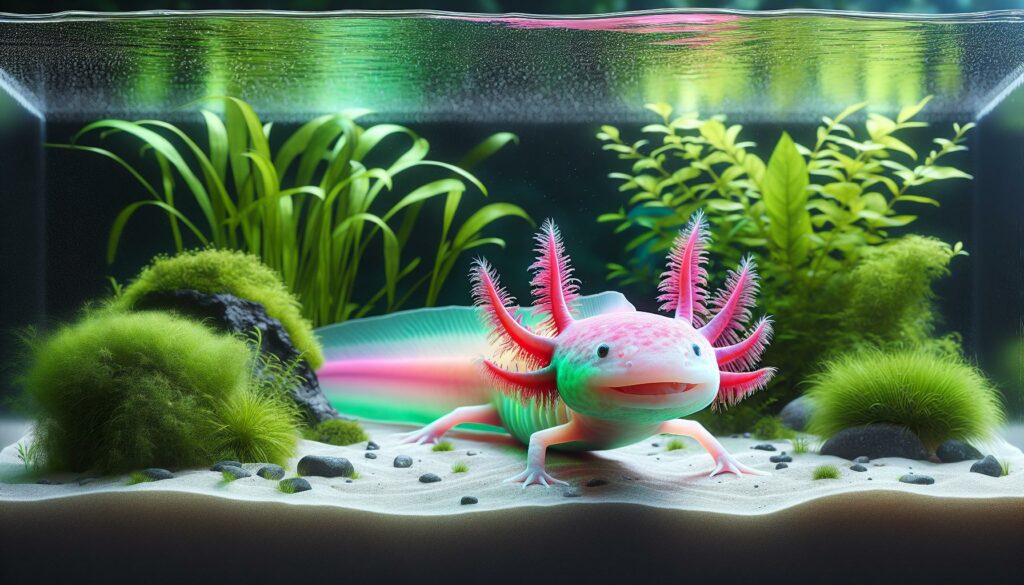Axolotls have captured the hearts of many with their unique appearance and fascinating abilities. These enchanting creatures, often referred to as “”Mexican walking fish,”” are actually amphibians that never undergo complete metamorphosis. Instead of transitioning to a terrestrial form, they retain their juvenile features throughout their lives, making them truly one-of-a-kind.
As a proud axolotl enthusiast, I can’t help but marvel at their vibrant colors and friendly demeanor. Whether you’re considering one as a pet or simply curious about their biology, understanding these remarkable beings opens up a world of wonder. Join me as we dive into the captivating world of axolotls, exploring their care, habitat, and the reasons behind their growing popularity.
- Unique Amphibian: Axolotls, often called “”Mexican walking fish,”” retain juvenile features, never undergoing complete metamorphosis, resulting in their fascinating appearance.
- Specific Variant: The Baby:rtb6o-dzbtk= axolotl showcases distinct coloration patterns and is recognized for its friendly temperament and remarkable regenerative abilities.
- Optimal Habitat: These axolotls thrive in well-maintained aquariums with clean, cool water (60°F to 68°F) and a pH level of 6.5 to 8.0, replicating their natural environments effectively.
- Balanced Diet: Feeding guidelines include high-quality pellets, earthworms, and brine shrimp; young axolotls should be fed daily while adults can be fed every other day.
- Health Monitoring: Regularly check water quality and watch for common health issues like skin infections and gastrointestinal problems, ensuring the axolotls remain healthy and active.
- Social Creatures: Axolotls display curiosity and social behaviors, making interactions with their owners enjoyable, especially when routines are established around feeding.
Baby:rtb6o-dzbtk= Axolotl
The Baby:rtb6o-dzbtk= axolotl represents a unique variant of the axolotl species. This specific type showcases distinct coloration patterns that set it apart from other axolotls. Known for their friendly demeanor, these axolotls thrive in aquatic environments, exhibiting remarkable regenerative abilities.
Similarly to other axolotls, Baby:rtb6o-dzbtk= axolotls maintain their gills throughout their lives, making them particularly captivating. Their external gills, feathered and vibrant, enhance their appearance while serving vital respiratory functions.
Understanding their habitat is crucial for proper care. Baby:rtb6o-dzbtk= axolotls require a well-maintained aquarium with clean, cool water, ideally between 60°F and 68°F. Additionally, maintaining a pH level of 6.5 to 8.0 supports their health and well-being.
Feeding them appropriately influences their growth and development. A diet comprising high-quality pellets, earthworms, and brine shrimp meets their nutritional needs. Young axolotls should be fed daily, while adults can receive food every other day, promoting optimal health.
Monitoring water quality and temperature remains vital for these sensitive creatures. Regular water changes and the use of filtration systems contribute significantly to their overall environment. Maintaining a stable ecosystem ensures the Baby:rtb6o-dzbtk= axolotl thrives in captivity, showcasing its playful nature and stunning appearance.
Physical Characteristics
Axolotls boast distinctive physical features that make them easily recognizable. Their vibrant colors and unique structures contribute to their charm and popularity among enthusiasts.
Size and Color Variations
Baby:rtb6o-dzbtk= axolotls typically measure between 6 to 10 inches in length when fully grown. Their size can vary slightly based on age and care. In terms of color, they exhibit a range of shades, including white, gray, and shades of pink to green. Some variations present striking patterns that enhance their aesthetic appeal, capturing the attention of both novice and experienced aquarists.
Unique Features
Axolotls are renowned for their external gills, which branch out from the sides of their heads, providing a captivating look. These feathery structures play a vital role in respiration, making them essential to their aquatic lifestyle. Additionally, their ability to regenerate limbs and other body parts adds to their fascinating biology, setting them apart from many other amphibians. Their wide, flat heads and lidless eyes further contribute to their unique appearance, making them an intriguing species for study and care.
Habitat and Environment
Axolotls thrive in specific habitats that mirror their natural environment. Understanding these conditions is vital for their care and well-being.
Natural Habitat
Axolotls originate from the lake complex of Xochimilco in Mexico City. These unique amphibians inhabit freshwater lakes and canals with abundant vegetation and a soft substrate. The warm, shallow waters provide essential resources like food and oxygen. In their natural habitat, axolotls rely on plants for shelter and protection from predators. Preserving this environment is crucial since urbanization has significantly reduced their natural habitat.
Ideal Tank Conditions
Creating a suitable tank environment for Baby:rtb6o-dzbtk= axolotls involves replicating these natural conditions. The aquarium must maintain a temperature range of 60°F to 68°F. A pH level between 6.5 and 8.0 is recommended, reflecting their native waters. A sandy substrate suits their needs, allowing for natural behavior like burrowing. Including plants, like java moss, provides shelter while enhancing aesthetics, and adequate filtration helps ensure clean water. Regular water changes and monitoring ammonia levels support optimal health, allowing these stunning creatures to flourish.
Care Requirements
Caring for Baby:rtb6o-dzbtk= axolotls involves attention to their diet, environment, and health. Proper maintenance ensures these amphibians thrive in captivity.
Diet and Feeding Guidelines
Baby:rtb6o-dzbtk= axolotls require a balanced diet for optimal growth and health. High-quality pellets specifically formulated for axolotls serve as a staple food. I supplement their diet with earthworms and brine shrimp, which provide essential nutrients.
Feed juveniles daily, while adults thrive on every other day adjustments. Monitor portion sizes, ensuring they consume what’s provided without overfeeding. A variety in their diet enhances their well-being and vibrant colors.
Common Health Issues
Baby:rtb6o-dzbtk= axolotls face several potential health challenges. Common issues include skin infections, often due to poor water quality or stress. Regular water changes and consistent monitoring of ammonia levels mitigate this risk.
Gastrointestinal problems can arise from improper diet or overfeeding. Signs include bloating or shedding. Keeping a watchful eye on their behavior helps catch these issues early.
Familiarity with potential health concerns allows me to act quickly, ensuring my axolotls remain healthy and thriving.
Behavioral Traits
Axolotls exhibit a range of intriguing behavioral traits that reflect their unique adaptations and social nature. Understanding these behaviors is essential for providing optimal care and enhancing the bond between axolotls and their owners.
Social Behavior
Axolotls generally display social behaviors, often indicating curiosity as they wander through their environment. These amphibians typically thrive in a peaceful setting, where they explore their surroundings and interact with tank mates, if present. I’ve observed that groups can exhibit calmness, given adequate space and hiding spots to reduce stress. However, aggression sometimes surfaces if space is limited, especially during feeding times. Thus, careful monitoring of interactions is vital to ensure harmonious coexistence among tank occupants.
Interaction with Owners
Interacting with axolotls can be a rewarding experience, as these creatures often respond to their owners’ presence. They may swim towards the glass when approached, showcasing their friendly demeanor. Creating a routine for feeding can strengthen this interaction, as they learn to associate their owners with food. Gently placing a finger against the tank can elicit curious responses, with axolotls often following movement with their eyes. Such engagement helps establish trust and familiarity, enhancing the overall bond between an axolotl and its owner.
Caring for a Baby:rtb6o-dzbtk= axolotl is a rewarding experience that brings joy and fascination. Their unique traits and friendly demeanor make them captivating companions. By providing a suitable habitat and a balanced diet, I can ensure they thrive and display their vibrant colors.
As I continue to learn about these remarkable creatures, I’m reminded of their importance in both the pet trade and conservation efforts. Every axolotl has its own personality, and building a bond with them enhances the joy of ownership. Embracing their care and understanding their needs allows me to appreciate the beauty of these incredible amphibians even more.

